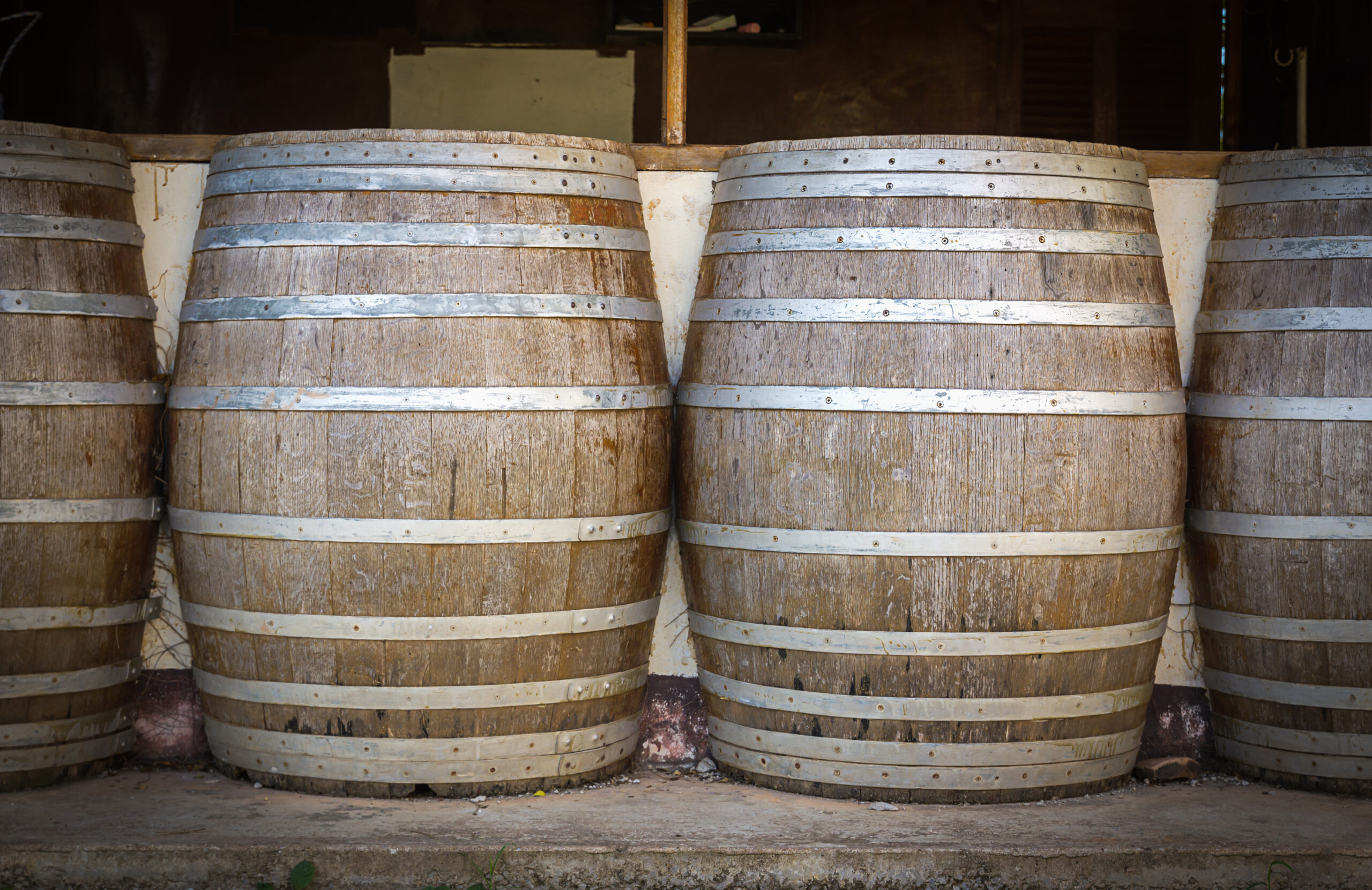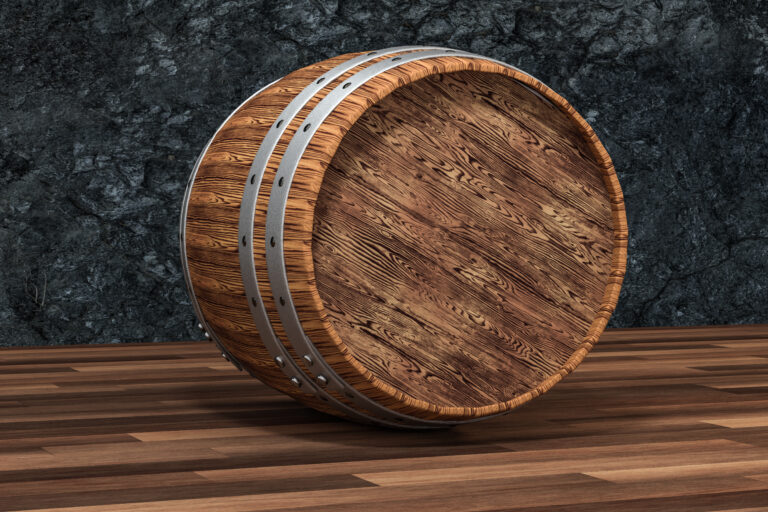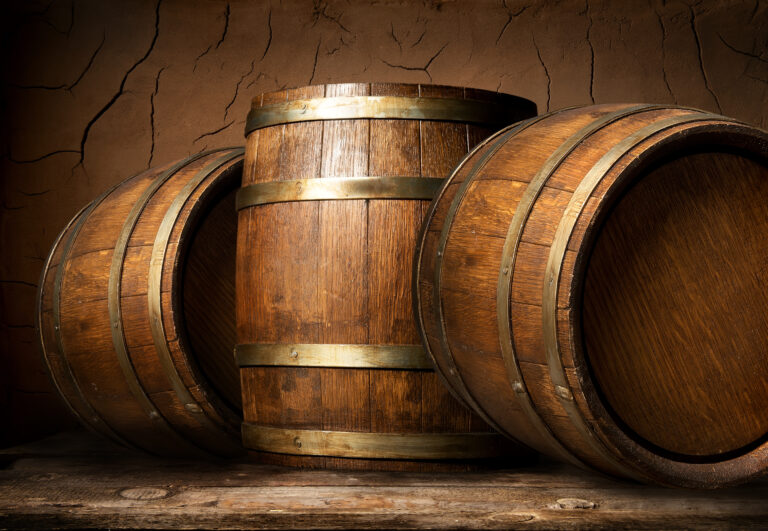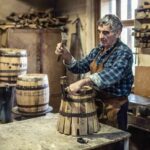Ever wondered why your favorite whiskeys boast delightful hints of vanilla, warm spice, or vibrant fruit? The true magic behind those intricate flavor profiles isn’t solely the grain or the yeast; it’s the barrels in which they patiently mature. These oak casks, often having previously cradled other fine spirits like rich bourbon or nuanced sherry, lend their unique character and aromatic complexity to the whiskey during its aging process. The porous wood acts like a sponge, absorbing the essence and hues of its former contents, which then slowly and gracefully infuse into the whiskey over years of slumber.
With every sip of whiskey, you’re not just tasting the distilled spirit; you’re experiencing the concentrated history held within that barrel. That subtle vanilla note might whisper of a previous life as a bourbon barrel, the delicate dried fruit flavors could echo a sherry cask, and a hint of spice might recall a rum barrel. Each cask leaves its own indelible fingerprint on the evolving whiskey. So, the next time you swirl and inhale the aromas of your dram, consider the invisible yet powerful hand of the barrel that helped craft that whiskey’s unique character. The surprising flavors in your whiskey each have a story to tell, a testament to the art of barrel aging.
Introduction to Barrel Aging and Its Influence on Flavor
The barrels employed in the aging of whiskey wield a profound influence over its ultimate flavor. As whiskey matures within these oak vessels, it diligently absorbs a myriad of compounds from the wood itself, contributing notes reminiscent of sweet vanilla and creamy coconut. However, the story doesn’t end there; barrels also generously impart flavors from their previous inhabitants.
Master distillers frequently select barrels that once held exquisite wines or rich sherries. The residual compounds from these earlier tenants gently seep into the maturing whiskey, bestowing delightful fruity notes. For instance, a bourbon that has rested in wine barrels might develop intriguing hints of fresh berries or succulent stone fruit. Similarly, whiskeys nurtured in sherry casks often exhibit a captivating nuttiness, accompanied by flavors of luscious dried fruits like plump raisins.
The adventurous spirit of some distilleries leads them to experiment with barrels that previously housed vibrant rum, earthy tequila, or elegant port. Rum barrels can introduce a touch of the tropics, with notes of ripe banana and sweet coconut. Tequila barrels may impart distinctive agave-based nuances. Port barrels tend to yield whiskeys with alluringly floral, almost chocolatey aromas.
Beyond the previous contents, the specific type of oak, the intensity of the barrel char, and even the age of the barrel itself play crucial roles. American oak is often associated with sweeter profiles, contributing more pronounced vanilla notes. French oak, on the other hand, is frequently described as imparting a spicier character. The degree of char or “toast” applied to the inside of the barrel dictates the extent to which the wood contributes its inherent flavors. Older barrels, having already shared much of their essence with previous spirits, tend to have a more subtle influence.
The world of barrel aging unlocks a breathtaking spectrum of flavors in whiskey. Master distillers meticulously select and manage their cask inventory to craft whiskeys with truly unique and remarkably complex flavor profiles. So, the next time you savor a well-aged whiskey, take a moment to appreciate the intricate layers of flavor that developed during its tranquil slumber in oak—and perhaps even imagine the stories those venerable barrels could tell.
Types of Barrels Used for Aging Whiskey
The distinctive flavor of whiskey is intrinsically linked to the barrel in which it matures, often more so than the specific grains used in its creation. The type of wood and the history of what was previously aged within that cask exert a significant influence on the final flavor profile of your beloved whiskey.
Oak is traditional
The time-honored choice for crafting whiskey barrels is oak, predominantly American white oak or carefully charred French oak. Oak wood generously contributes desirable flavors such as sweet vanilla, rich caramel, and warm spice. Notably, bourbon production, by law, mandates the use of new, charred oak barrels.
Used barrels add variety
Many distillers embrace the practice of aging their whiskey in used barrels that previously cradled other alcoholic beverages like fine wine, rich sherry, elegant port, or even robust beer. This reuse of casks introduces an array of additional flavors to the whiskey. For example, whiskeys matured in ex-sherry casks often develop delightful nutty and dried fruit flavors. Similarly, ex-wine barrels tend to impart more delicate floral and fruity notes.
Barrel char matters
The degree of char or “toast” applied to the interior surface of the barrel also plays a crucial role in shaping the flavor. Lightly toasted barrels tend to yield whiskeys with more pronounced oak and sweet vanilla notes. In contrast, heavily charred barrels often contribute richer flavors of caramel, dark chocolate, and subtle smoke. Some distillers even employ custom char levels to achieve highly specific and nuanced flavor profiles.
Location and climate
The environment in which barrels are aged can also subtly influence the flavor of the whiskey. Whiskey aged in warmer climates tends to mature at a faster rate, while cooler climates often result in a more pronounced oak influence. Warehouses with greater airflow can lead to increased oxidation, contributing to richer and darker flavors.
With such a multitude of factors influencing how barrels impart flavor to whiskey, it’s no wonder that different brands can exhibit such distinct characteristics. The precise combination of wood type, char level, and aging environment bestows upon each whiskey its unique and captivating personality. So, the next time you pour a dram, take a moment to appreciate the often-surprising influence of these remarkable barrels.
How Previous Barrel Contents Affect Whiskey Flavor
The barrels chosen to age and mellow whiskey exert a profound influence on its final flavor profile. During the maturation process, the wood interacts intimately with the spirit, imparting distinct characteristics that are shaped by several key factors:
Type of Wood
Oak barrels, particularly those crafted from charred American white oak, are the most prevalent choice for whiskey aging. Oak wood contains natural compounds such as lactones and vanillin, which contribute signature flavors of sweet vanilla, creamy coconut, and warm spice. The level of char or “toast” applied to the barrel significantly impacts the degree to which these flavors are absorbed into the whiskey. More heavily charred barrels tend to produce whiskeys with bolder and smokier notes.
Previous Contents
Barrels that have previously aged other alcoholic beverages, such as fine wine, rich sherry, or elegant port, generously impart subtle hints of their former residents. For example, ex-bourbon casks often contribute lighter, sweeter notes, while ex-sherry casks tend to yield complex dried fruit and nutty flavors. Some distillers deliberately reuse barrels to create highly specific and nuanced flavor profiles. The intricate interaction between the new spirit and the remnants of the previous contents can lead to truly delightful and unexpected flavor discoveries!
Age
The duration for which a whiskey rests within the barrel profoundly affects its flavor. Over time, the whiskey absorbs more wood compounds, resulting in a mellower and smoother character. Younger or “new make” spirits will retain more of their original grain flavors, while older whiskeys develop complex tertiary notes of warm spice, sweet vanilla, and rich caramel. Many premium whiskies are aged for 10-25 years to achieve a perfect harmony between the influence of the wood and the inherent character of the spirit.
Environment
Ambient factors such as temperature, humidity, and atmospheric pressure also play a role during maturation. Colder conditions tend to slow down the aging process, while warmer temperatures can accelerate it. Even the specific location of the barrel warehouse can contribute to regional characteristics. For instance, island whiskies are often described as having more robust, sea-inspired flavors due to the salty sea air.
While the initial ingredients and the distillation process lay the foundation for whiskey, it is the transformative power of the barrel that truly allows it to shine. Appreciating how these diverse factors influence flavor helps to unlock the fascinating mysteries behind how great whiskies acquire their distinctive and captivating tastes.
Bourbon: The Impact of Charred New Oak Barrels
Bourbon whiskey derives its distinctive and often sweet flavor from a mandatory aging process in charred new oak barrels, particularly those that have not previously held any other spirit. The charring process caramelizes the natural sugars within the wood, imparting delightful notes of sweet vanilla and warm spice. These new oak barrels also contribute tannins, which provide structure and a pleasant mouthfeel to the bourbon.
The Impact of Wood Type
American white oak stands as the undisputed wood of choice for crafting bourbon barrels. Its tight grain and ideal permeability make it perfectly suited for aging spirits. However, oak sourced from different geographical regions can impart subtly different flavors. For example, wood from the Ozark Mountains might contribute more robust and spice-forward notes to the bourbon, while wood from Minnesota and Wisconsin could lead to bourbons with more delicate floral and fruit-forward profiles.
Char Level Matters
The intensity of the char applied to the inside of the barrels significantly influences the resulting flavor. Barrels with a lighter char or “toast” will tend to produce bourbons with more pronounced oak and natural wood sugar flavors. Conversely, a heavier char often leads to bourbons with richer notes of caramel and vanilla, accompanied by hints of cocoa or even espresso. Master distillers meticulously control the char level to achieve their desired and signature flavor profiles.
The Previous Tenant
While bourbon regulations mandate the use of new charred oak barrels, some innovative distillers will utilize barrels that previously aged other spirits, such as vibrant rum or fine wine, to add intriguing new flavor dimensions to their bourbon. For instance, rum barrels might introduce hints of tropical fruit or rich molasses, while wine barrels can contribute delicate berry-like notes. These alternative barrels are often employed for finishing bourbons, creating unique and highly sought-after special releases.
Maturation Period
The length of time a bourbon spends aging in the barrel is a crucial factor in developing its complexity. As it matures, the bourbon diligently extracts different compounds from the wood and undergoes chemical transformations that create new and nuanced flavors. Bourbons aged for 3-5 years tend to be vibrant and oak-forward. Those aged for 8-12 years often develop richer caramel and spice flavors. Bourbons aged for 15 years and beyond can take on more complex nutty and leathery aromas, sometimes with hints of tobacco or dark chocolate. The maturation period is a key element in crafting a bourbon’s unique flavor fingerprint.
Ultimately, the interplay of characteristics imparted by the wood type, the char level, any previous barrel contents, and the duration of aging all contribute to the final taste of your favorite bourbon. Master distillers thoughtfully select and blend barrels to create a balanced and complex flavor that becomes recognizably their own.
Scotch: The Complexities of Used Barrels
Scotch whisky distinguishes itself by its aging process in used barrels, often those that previously held rich bourbon or nuanced sherry. This practice imbues each bottle of scotch with a unique tapestry of flavor notes. The residual character of the barrel’s former contents subtly yet significantly influences the evolving flavor of the scotch.
Bourbon Barrels
Bourbon barrels are the most commonly employed for aging scotch. Crafted from American white oak and charred before their initial use, they impart a distinctive sweetness of vanilla and rich caramel to the scotch, often accompanied by a subtle smoky aroma derived from the charred wood. It’s important to note that the age statements on scotch bottles refer to the youngest whisky in the blend. As the scotch ages longer in these barrels, these characteristic flavors become more pronounced and integrated.
Sherry Casks
Sherry casks contribute a different dimension of flavor, adding rich and often intense fruity flavors to the maturing scotch. The fortified sherry wine deeply permeates the wood, imparting notes of luscious dried fruits like raisins, plump prunes, and sweet cherries, often accompanied by a subtle nuttiness and warm spice. Renowned distilleries like Macallan and Glenfarclas are particularly celebrated for their tradition of aging scotch in sherry casks. The harmonious interplay between the sherry and oak flavors creates a sweet and full-bodied scotch experience.
Other Barrels
In the pursuit of unique and memorable flavor profiles, some adventurous distillers experiment with a wider range of barrels, including those that previously held elegant port, rich madeira, or vibrant rum. This exploration adds remarkable variety to the world of scotch. For instance, port or madeira casks can impart delicate floral and fruity notes, while rum barrels might introduce intriguing tropical flavors. The strategic use of multiple barrel types in the creation of a single bottle can result in a captivating symphony of complex tastes.
Ultimately, the type of barrel chosen for aging scotch, and the duration of that aging process, exert an enormous influence on its final taste and aroma. While bourbon and sherry casks remain traditional cornerstones, many distillers are venturing into the realm of other barrel types to craft distinct and unforgettable flavor profiles. The unique character of a single malt scotch, in particular, owes a great deal to the mastery of the distiller in carefully selecting and skillfully blending barrels. The legacy of the barrel’s previous contents lives on, leaving a lasting imprint on the character of the scotch.
Japanese Whisky: Focus on Specific Oak Types
Japanese whiskies have garnered global acclaim for their remarkably delicate and intricately layered flavors. A significant portion of this recognition can be attributed to the meticulous selection of barrels used for aging the spirit. Distillers in Japan thoughtfully source oak from various regions, including the United States, Spain, and Japan itself, to craft truly unique flavor profiles in their esteemed whiskies.
Japanese Oak
Japanese oak, also known as mizunara, is highly prized for the distinctive and often exotic aromas it imparts, reminiscent of fragrant incense, warm sandalwood, and sweet coconut. However, this unique oak presents challenges due to its porous nature, making it more difficult to work with. Whiskies aged in mizunara barrels, such as select offerings from Yamazaki or Hakushu single malts, tend to exhibit a lighter and more fruit-forward character, often with those signature aromatic notes.
American Oak
Ex-bourbon barrels sourced from the United States are commonly employed in the aging of Japanese whisky. These barrels generously contribute familiar notes of sweet vanilla, rich caramel, and warm spice, providing a foundational layer of flavor. Distilleries such as Chichibu, Mars, and White Oak are particularly known for their whiskies aged in American oak.
Spanish Oak
Oloroso sherry barrels from Spain are also highly valued by Japanese distillers. These casks impart rich flavors of luscious dried fruit, subtle nuts, and hints of dark chocolate. The sherry that previously matured in these barrels deeply permeates the wood, significantly influencing the character of the aging whisky. Look for whiskies from distilleries like Akashi or Chita that have been aged in sherry casks for a sweet and nutty dram.
Blending Barrels
Many Japanese distilleries skillfully employ the art of blending whiskies that have matured in multiple barrel types to create exceptionally complex flavors. The award-winning Yamazaki 12 Year, for example, is a masterful blend of whiskies aged in American, Spanish, and Japanese oak. Its layered flavors of warm spice, bright citrus, and rich dried fruit beautifully demonstrate how strategic barrel blending can lead to an extraordinary whisky experience.
Ultimately, the type of oak, its geographical origin, and the duration for which the spirit matures within the barrel all significantly impact the aroma, taste, mouthfeel, and finish of Japanese whisky. The willingness to experiment with different barrels allows distillers to craft a diverse range of distinct flavor profiles to suit the discerning palate of any whisky enthusiast. What the barrel imparts, the whisky gracefully absorbs, resulting in the unique character that defines Japanese whisky.
Irish Whiskey: New Interest in Different Cask Types
Irish whiskey is experiencing a resurgence in global interest and appreciation. In this dynamic landscape, distillers are increasingly experimenting with a diverse array of cask types to craft unique and compelling flavor profiles in their esteemed whiskeys.
Sherry Casks
For many decades, sherry casks sourced from Spain were a common choice for aging Irish whiskey. The sherry-infused wood imparts rich flavors of dried fruit, subtle nuts, and warm spice to the maturing whiskey. Today, many distilleries are refining this tradition by utilizing specific types of sherry casks, such as those that previously held Oloroso or Pedro Ximénez (PX) sherry, to produce whiskies with even more distinct and nuanced tastes.
Rum Casks
Embracing a more tropical influence, some distillers are aging their whiskies in used rum casks sourced from the Caribbean. These rum barrels contribute vibrant tropical flavors reminiscent of ripe banana, sweet coconut, and rich molasses. A growing number of brands have released rum cask-finished whiskies that offer a distinctly sweet and vibrant character.
Wine Casks
Both red wine and white wine casks are finding their place in the finishing stages of some Irish whiskies. These wine barrels impart delicate fruity flavors to the whiskey, such as notes of fresh berry, succulent stone fruit, and bright citrus. Several distilleries have released intriguing wine cask-finished whiskies utilizing port, Madeira, or Sauvignon Blanc casks.
Other Casks
Demonstrating remarkable creativity, some distillers are venturing beyond traditional casks, employing those that previously held fortified wines, craft beers, or other distinctive spirits to finish their whiskies. These unique casks can yield whiskies with unusual and captivating flavors not commonly encountered in traditional Irish whiskies. A few notable examples include Irish whiskies finished in Marsala, IPA, and even Mezcal casks.
While the classic pot still and single malt Irish whiskies will always remain cherished mainstays, the emergence of new types of cask-finished and double cask-matured Irish whiskies is attracting a new wave of whiskey enthusiasts. By boldly experimenting with diverse cask types, Irish distillers are crafting innovative whiskies with increasingly complex and exciting flavors. The sheer variety of Irish whiskies available today has never been greater, ensuring that every whiskey drinker can discover an Irish whiskey perfectly suited to their individual tastes.
Rye and Wheat Whiskies: The Spice Dimension
Rye and wheat whiskies stand apart in the whiskey world, largely defined by their inherent spice characteristics. The specific grains used in their production impart distinctive flavors that offer a departure from the more common caramel and vanilla notes often associated with bourbon.
Rye
Rye whiskey, by definition, must be crafted from a mash bill containing at least 51% rye grain, along with malted barley. Rye grains contribute peppery and earthy flavors to the resulting whiskey. This characteristic spiciness often comes through quite clearly, particularly in younger expressions. As rye whiskey matures, these peppery notes tend to mellow, evolving into warmer nuances of cinnamon, clove, and nutmeg. The previous contents of the aging barrels also play a significant role in shaping the final flavor, with port or rum barrels, for instance, adding delightful fruity and sweet dimensions.
Wheat
Wheat whiskey, made with a mash bill containing at least 51% wheat grain, is often considered the lightest and sweetest among the main whiskey styles. Wheat grains impart a soft and creamy mouthfeel to the whiskey, accompanied by gentle notes of honey, subtle nuts, and delicate stone fruit. Wheat whiskies tend to be very approachable, with the natural sweetness of the grain often balancing out the inherent warmth of the alcohol. While sometimes aged in used oak barrels, they are also frequently matured in barrels that previously held port, sherry, or other wines. These former tenants can contribute additional layers of flavor, such as notes of ripe cherry, sweet raisin, or juicy apricot.
As with other whiskey types, the specific type of oak, the intensity of the char level, and the history of the barrels used all have a significant impact on the final flavor profiles of both rye and wheat whiskies. Master distillers carefully select and blend barrels to achieve their desired and signature flavor profiles. Furthermore, the geographical location of the distillery and the local climate can also subtly shape the distinctive characteristics of these whiskies.
Rye and wheat whiskies offer whiskey lovers an exciting opportunity to venture beyond the familiar flavors of bourbon and explore a spicier and often tangier realm. If you’re looking to expand your whiskey horizons, starting with a few samples of these spunky and full-flavored whiskies might just lead you to discover a new favorite.
The Influence of Previous Barrel Contents on Whiskey Flavor Profiles: Key Takeaways
The barrels employed in the aging of whiskey exert a profound influence on its ultimate flavor profile. Crafted primarily from oak, these casks allow the whiskey to gradually absorb desirable characteristics from the wood over time. However, the story often goes deeper, as barrels are frequently reused, and their previous contents can also significantly shape the whiskey’s final taste.
Charred Barrels
The majority of distillers utilize charred oak barrels for aging whiskey. The charring process caramelizes the natural sugars present in the wood, imparting a signature sweet and subtly smoky flavor to the whiskey. The degree of char applied to the barrel directly correlates with the intensity of the flavor imparted – lightly charred barrels tend to yield more subtle flavors, while heavily charred barrels contribute more robust and smoky tones.
Bourbon Barrels
Regulations stipulate that bourbon must be aged in new, charred American white oak barrels. Once these barrels have fulfilled their duty in aging bourbon, they are often sold to distillers in Scotland and Ireland for the aging of scotch and Irish whiskeys. The residual bourbon flavors permeate the wood, subtly influencing the character of the subsequent whiskeys. You might detect underlying notes of sweet vanilla, rich caramel, and warm spice – the unmistakable signatures of bourbon.
Sherry and Port Barrels
Many distillers embrace the practice of aging whiskey in used sherry, port, rum, or wine barrels to create unique and complex flavor profiles. The remnants of the previous contents seep into the wood, imparting delightful dried fruit, subtle nut, and delicate grape flavors to the maturing whiskey. For example, whiskey aged in sherry casks may exhibit flavors of plump raisins, sweet prunes, and subtle nuts, while port casks can contribute notes of fresh berries, ripe cherries, and even hints of dark chocolate.
Multiple Barrels
Some distillers masterfully employ a variety of barrel types during the aging process to create exceptionally complex whiskies with multiple layers of flavor. They might initiate the aging in traditional charred oak barrels and then transfer the whiskey to used sherry or port barrels for a period of additional maturation, a process known as “finishing.” By strategically blending whiskies aged in different barrels, master distillers can craft truly distinctive and nuanced taste profiles.
In conclusion, the type of barrels employed and their previous contents exert an enormous influence on a whiskey’s final flavor and aroma. Charred oak provides a foundational smoky base, while used barrels contribute a captivating array of fruit, nut, and spice notes. By understanding how barrels affect taste, you can more effectively select whiskies with flavor profiles that perfectly align with your individual preferences.
Final Thoughts
So, the next time you pour yourself a glass of fine bourbon or elegant Scotch, take a moment to contemplate the remarkable journey that liquid has undertaken. The intricate flavors you detect were meticulously shaped by years of intimate interaction with wood and char, a slow and graceful exchange of aroma and taste compounds. The barrel’s history matters too – whether it once cradled rich port, nuanced sherry, or vibrant rum, those lingering remnants have left their indelible mark, transforming your drink into something truly unique. While whiskey is often celebrated for its provenance and place, it’s easy to overlook the humble barrel’s crucial role in crafting a spirit’s final personality. These unassuming casks impart the distinctive qualities that allow us to explore the diverse and captivating world of whiskey. Their often-hidden influence deserves greater appreciation and recognition from all who savor the fruits of their silent labor.







